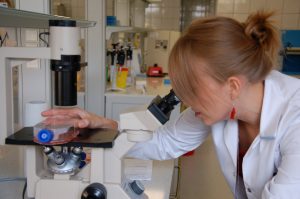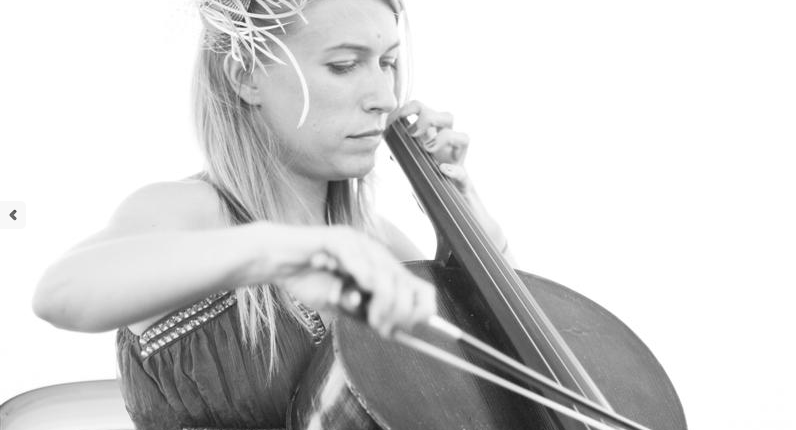Agata Kurzyk: The hypothetical existence of multiple universes as a musical inspiration
For Agata Kurzyk, a stem cell researcher from Warsaw, combining music and science is all about problem-solving. “Learning how to solve an unconventional problem teaches you to have patience and a humble approach”, she says.
Cześć, Agata! Can you elevator-pitch for us what your current research is about?
The main objective of my research is the use of mesenchymal stem cells isolated from adipose tissue for bone tissue engineering and regenerative medicine. I am particularly interested in optimisation of cell seeding efficiencies on 3D biodegradable polymers and I look for a novel way to deliver stem cells (e.g. using microbubbles) for medical applications (e.g. drug delivery, tissue engineering, regenerative medicine).
And your musical projects? What is looping exactly?
In electroacoustic music, a loop is a repeating section of sound material. Short sections of material can be repeated to create a huge pattern of sounds. I typically record cello phrases, then play them back and determine the phrases that work best together. For this process, I use loop station and also a combination of microphones and pickups attached to the body of the cello.
Click here to watch an example of looping!
You mention on your website that “overlapping rhythms and chords move the listener into another dimension of sound”. Fun question, do you also believe in the existence of different dimensions and parallel universes?
Yes. This is the basis of my music creation! Although the multiverse is a hypothetical set of various possible universes, faith in them allows me to believe there is a parallel world somewhere, where I live and make different decisions than here. I wonder what effect they would have and whether I’m happy out there. These thoughts are very exciting and they inspire me to live boldly.
When and how did you come up with the idea of combining cello with electronics (theme looping technique)?
What I wanted to do was to take orchestral cello music and combine it with the sound design techniques of electronic music. The cello can make a huge array of sounds; it’s a really versatile instrument. And I’m still exploring the boundaries of the cello to see what kind of sounds I can get.
I can tap the cello with my hand (sometimes), I use the bow and I brush the wood. I use percussion brushes or I use sticks which I put between the strings. I do all kind of things. I try to combine this sound with electronics and different sound effects (e.g. reverb, delay, octave bass, dynamic wah). I’m experimenting with loops all the time. How to transform those loops into compositions? There are a lot of layers in my music. I spend a lot of time working out what the arrangements should be. In addition, the integral part of my play is improvisation. I love looking for new sounds! It’s like building the instrument with your own unique sound – your own voice. Sometimes, I try to create something from scratch or I create something as a reaction to another thing. It’s a very abstract process. Sometimes, I try to capture a feeling of motion, caused by moving towards or away from something, and that thing is unknown. I really like moving into an unknown world. Being a scientist, sometimes I ask myself “Could we hear cell division? Or the movement of biological or physical changes?”. I just try to connect what I know as a scientist with “the abstract side” and then translate it into music. Of course, not only science is my inspiration. I get most of my inspiration from walking around and looking at the world thinking/being outside of it.
“So I drew on a piece of paper every stage of embryogenesis, and I saw that division of cells may be the perfect material for music”
Two passions: Science and music. How do you manage to combine them? Any suggestions for other bipassionate artists?
To be honest, because it’s very difficult to join both passions, I never force myself to do this. I just try to be in harmony with myself and take everything as it comes. Happily, each day is different and I learn to perfect improvisation during the day. It makes me not frustrated and I may use the unplanned free time to play cello or do experiments.
I accepted that sometimes I have extra time for music or sometimes for science. And I’ m fine with it. I feel satisfied.
How has being a scientist influenced your musical life and vice versa?
If I didn’t deal with music and science, my life would certainly not be so colourful, surprising and unpredictable. Many of the situations that I experience result from this combination. Combining art with science taught me the most important skill – looking for many solutions to one problem. Besides, music connects people regardless of what they do and who they are. This definitely facilitates work in the lab or while negotiating conditions when purchasing RT-PCR or juicer. Also, learning how to solve an unconventional problem teaches you to have patience and a humble approach. The monotonous repetition of long experiments is easier to bear, like a long practice playing the cello. And as we all know, without exercise there are no effect!
“Embryocells” is the title of one of your songs. Like the egg and the chicken, which came first, the rhythm or the scientific inspiration?
The story of this composition is related to my studies at the Fryderyk Chopin University of Music in Warsaw. My professor from the composition said: “Agata, write a composition that is related to something that is currently close to you”. During this time I prepared a small paper about embryogenesis and I spent every spare moment over stages of embryonic development. Really, I didn’t think about anything else… So I drew on a piece of paper every stage of embryogenesis, and I saw that division of cells may be the perfect material for music. That’s how “Embryocells” was created! I locked myself in the room and started playing every thought and feeling related to cell division. I’ll never forget the focused face of my professor, who carefully listened to the structure of this piece and my sound samples. It was a great feeling, to be able to show others what you are learning but in another dimension. “Embryocells” was premiered in 2015 at the University of Music in Warsaw and this is one of my favourite compositions.
And I read it is composed for 6 cellos. Any similarity with number of cells?
Haha, no, no! 6 is the perfect number of cellos to perform this piece.
To end, what is the one thing that can never be missing in your music equipment when having a concert? And how about on your lab bench during a crucial experiment?
I always have with me a double set of cables, cello strings, drum brushes and extension cords. I never forget rosin*. Before a crucial experiment I plan every stage on a piece of paper, and then I prepare my lab bench (e.g. reagents, materials, pipettes, tips) – like before concerts! If something should be prepared in advance, I do it. Everything that I need is actually where I can reach it. I like working in the early morning when everyone is just rubbing their eyes and drinking a sip of coffee.
ABOUT HER
Music studies: Music School degree I and II in Tomaszow Mazowiecki (Poland). Currently a student of composition in Postgraduate Studies at the Fryderyk Chopin Academy of Music in Warsaw.
Scientific career: Biotechnology graduate (MSc Eng) with specialization in Technical Biochemistry and Molecular Biology at the Technical University of Łódź. Currently working at the Department of Regenerative Medicine at the Maria Sklodowska-Curie Memorial Cancer Center and Institute of Oncology in Poland.
Her first cello: “I got my first cello after 3 months of learning. It was a cello borrowed from a music school. 10 years later I bought my own cello. I found her in the wardrobe of an old house, where no one wanted her anymore. It turned out years later that this cello is from the interwar period, and was made by a Polish luthier from Poznan, whose family still today has violin-maker workshops and multi-generational musical traditions. Sometimes it’s worth waiting long for your instrument.”
Visit her personal website here!
* Rosin is a type of resin used on bows to make them sticky and obtain a better grip.







Brilliant interview!